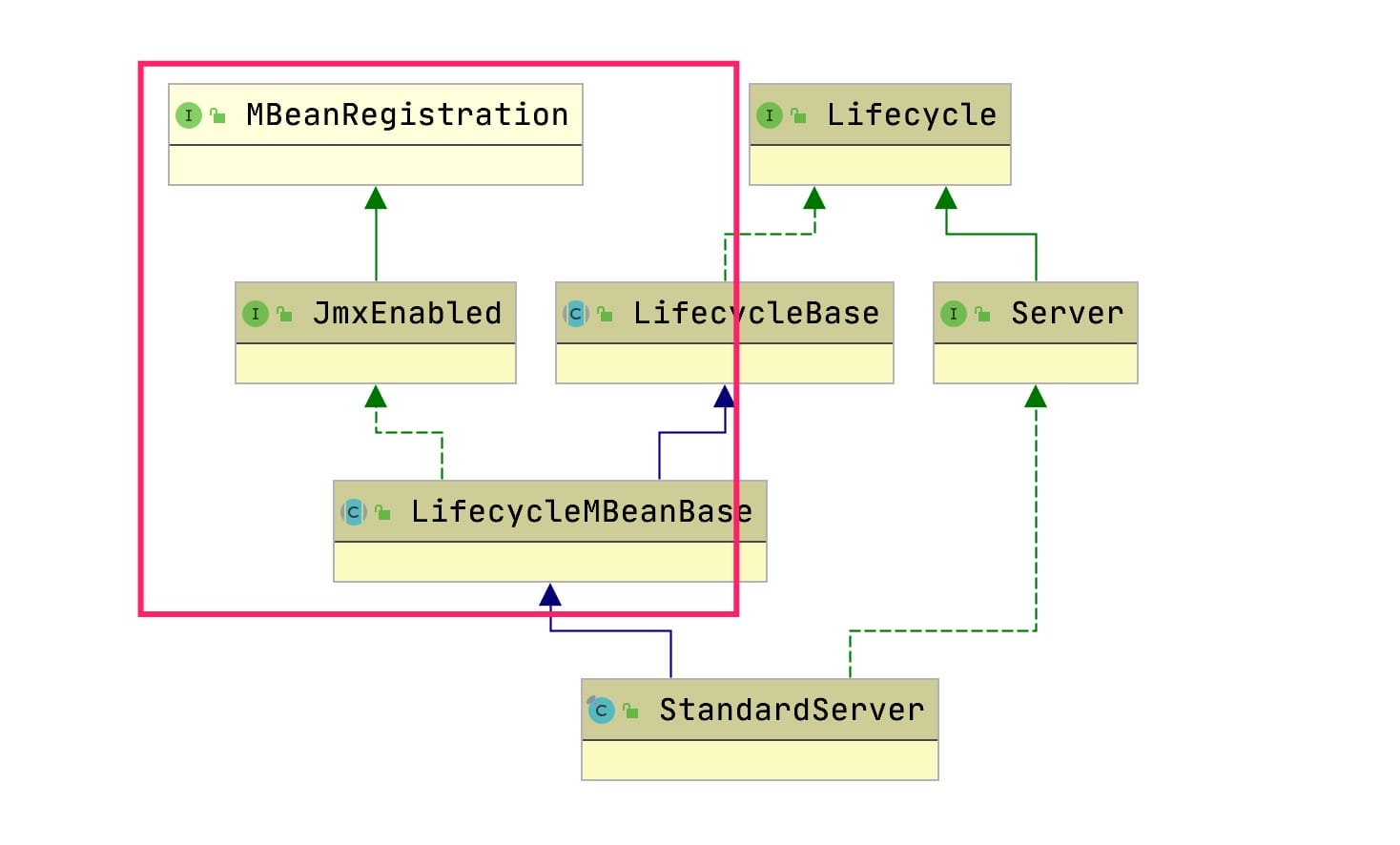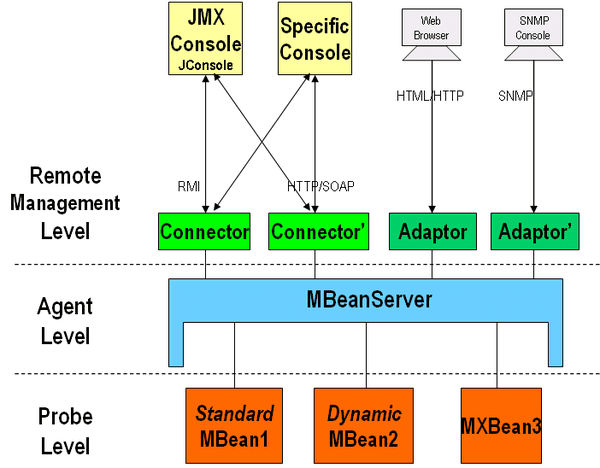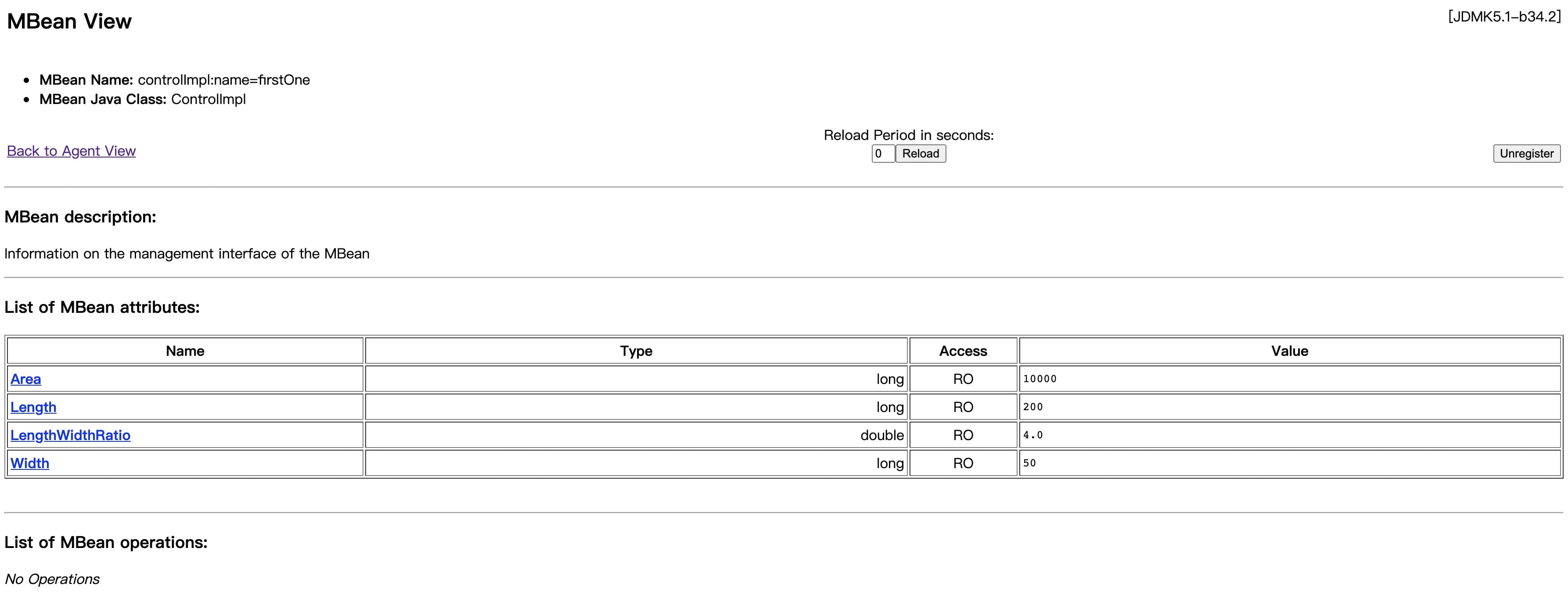Tomcat - 组件拓展管理:JMX和MBean
我们在前文中讲Lifecycle以及组件,怎么会突然讲JMX和MBean呢?本文通过承接上文Lifecycle讲Tomcat基于JMX的实现。@pdai
引入
我们在前文中讲Lifecycle以及组件,怎么会突然讲JMX和MBean呢?本文通过承接上文Lifecycle讲Tomcat基于JMX的实现。
为什么要了解JMX
我们在上文中讲Lifecycle和相关组件时,你会发现其实还设计一块就是左侧的JMX和MBean的实现,即LifecycleMBeanBase.

什么是JMX和MBean
JMX是java1.5中引入的新特性。JMX全称为“Java Management Extension”,即Java管理扩展。
JMX(Java Management Extensions)是一个为应用程序植入管理功能的框架。JMX是一套标准的代理和服务,实际上,用户可以在任何Java应用程序中使用这些代理和服务实现管理。它使用了最简单的一类javaBean,使用有名的MBean,其内部包含了数据信息,这些信息可能是程序配置信息、模块信息、系统信息、统计信息等。MBean可以操作可读可写的属性、直接操作某些函数。
应用场景:中间件软件WebLogic的管理页面就是基于JMX开发的,而JBoss则整个系统都基于JMX构架,我们今天讲的Tomcat也是基于JMX开发而来的。
我们看下JMX的结构

- Probe Level 负责资源的检测(获取信息),包含MBeans,通常也叫做Instrumentation Level。MX管理构件(MBean)分为四种形式,分别是标准管理构件(Standard MBean)、动态管理构件(Dynamic MBean)、开放管理构件(Open Mbean)和模型管理构件(Model MBean)。
- The Agent Level 或者叫做MBean Server(代理服务器),是JMX的核心,连接Mbeans和远程监控程序。
- Remote Management Level 通过connectors和adaptors来远程操作MBean Server。
JMX使用案例
上节只是引入和相关概念,这是不够的,你依然需要一个案例来帮助你理解JMX是如何工作的。
基于JMX的监控例子
- ServerImpl - 我们模拟的某个服务器ServerImpl状态
public class ServerImpl {
public final long startTime;
public ServerImpl() {
startTime = System.currentTimeMillis();
}
}
- 由于MXBean规定,标准MBean也要实现一个接口,其所有向外界公开的方法都要在该接口中声明,否则管理系统就不能从中获取信息。此外,该接口的命名有一定的规范:在标准MBean类名后加上MBean后缀。这里的标准MBean类就是ServerMonitor,所以其对应的接口就应该是ServerMonitorMBean。因此ServerMonitorMBean的实现如下
public interface ServerMonitorMBean {
public long getUpTime();
}
- 使用ServerMonitor类来监测ServerImpl的状态,实现如下
public class ServerMonitor implements ServerMonitorMBean {
private final ServerImpl target;
public ServerMonitor(ServerImpl target) {
this.target = target;
}
@Override
public long getUpTime() {
return System.currentTimeMillis() - target.startTime;
}
}
- 对于管理系统来讲,这些MBean中公开的方法,最终会被JMX转换为属性(Attribute)、监听(Listener)和调用(Invoke)的概念。下面代码中Main类的manage方法就模拟了管理程序是如何获取监测到的属性,并表现监测结果。
import javax.management.MBeanServer;
import javax.management.MBeanServerFactory;
import javax.management.ObjectName;
public class Main {
private static ObjectName objectName;
private static MBeanServer mBeanServer;
public static void main(String[] args) throws Exception {
init();
manage();
}
private static void init() throws Exception {
ServerImpl serverImpl = new ServerImpl();
ServerMonitor serverMonitor = new ServerMonitor(serverImpl);
mBeanServer = MBeanServerFactory.createMBeanServer();
objectName = new ObjectName("objectName:id=ServerMonitor1");
// 注册到MBeanServer
mBeanServer.registerMBean(serverMonitor, objectName);
}
private static void manage() throws Exception {
// 获取属性值
long upTime = (Long)mBeanServer.getAttribute(objectName, "UpTime");
System.out.println(upTime);
}
}
- 整体流程

如上步骤就能让你理解常见的Jconsole是如何通过JMX获取属性,对象等监控信息的了。
基于JMX的HTMLAdapter案例
上面例子,还没有体现adapter展示,比如上述信息在HTML页面中展示出来,再看一个例子
- 我们的管理目标
public class ControlTarget {
private long width;
private long length;
public ControlTarget( long width, long length) {
this.width = width;
this.length = length;
}
public long getWidth() {
return width;
}
public long getLength() {
return length;
}
}
- 根据标准MBean类抽象出符合规范的MBean类的接口,并修改标准MBean类实现该接口。
public interface ControlImplMBean {
public long getLength();
public long getWidth();
public long getArea();
public double getLengthWidthRatio();
}
- 根据需求,创建管理(目标程序)的类,其中包含操纵和获取(目标程序)特性的方法。这个类就是标准MBean类。
public class ControlImpl implements ControlImplMBean {
private ControlTarget target;
public ControlImpl(ControlTarget target) {
this.target = target;
}
@Override
public long getLength() {
return target.getLength();
}
@Override
public long getWidth() {
return target.getWidth();
}
@Override
public long getArea() {
return target.getLength() * target.getWidth();
}
@Override
public double getLengthWidthRatio() {
return target.getLength() * 1.0f / target.getWidth();
}
}
- 创建MBean的代理类,代理中包含创建MBeanServer、生成ObjectName、注册MBean、表现MBean
import com.sun.jdmk.comm.HtmlAdaptorServer;
import javax.management.*;
public class ControlImplAgent {
public static void main(String[] args) throws MalformedObjectNameException, NullPointerException, InstanceAlreadyExistsException, MBeanRegistrationException, NotCompliantMBeanException {
// 创建MBeanServer
MBeanServer server = MBeanServerFactory.createMBeanServer();
// 为MBean创建ObjectName
ObjectName controlImplName = new ObjectName("controlImpl:name=firstOne");
// 注册MBean到Server中
server.registerMBean(new ControlImpl(new ControlTarget(50, 200)), controlImplName);
// 表现MBean(一种方式)
ObjectName adapterName = new ObjectName("ControlImpl:name=htmladapter,port=8082");
HtmlAdaptorServer adapter = new HtmlAdaptorServer();
server.registerMBean(adapter, adapterName);
adapter.start();
//adapter.stop();
}
}
- 打开相关页面
PS:相关Adapter可以通过这里下载https://download.csdn.net/download/com_ma/10379741

点击最后一个链接

Tomcat如何通过JMX实现组件管理
在简单理解了JMX概念和案例之后,我们便可以开始学习Tomcat基于JMX的实现了。

上述图中,我们看下相关的类的用途
MBeanRegistration:Java JMX框架提供的注册MBean的接口,引入此接口是为了便于使用JMX提供的管理功能;JmxEnabled: 此接口由组件实现,这些组件在创建时将注册到MBean服务器,在销毁时将注销这些组件。它主要是由实现生命周期的组件来实现的,但并不是专门为它们实现的。LifecycleMBeanBase:Tomcat提供的对MBeanRegistration的抽象实现类,运用抽象模板模式将所有容器统一注册到JMX;
此外,ContainerBase、StandardServer、StandardService、WebappLoader、Connector、StandardContext、StandardEngine、StandardHost、StandardWrapper等容器都继承了LifecycleMBeanBase,因此这些容器都具有了同样的生命周期并可以通过JMX进行管理。
MBeanRegistration
理解MBeanRegistration主要在于:
- 两块内容:registered 和 unregistered
- 两类方法:before和after
public interface MBeanRegistration {
// 在注册之前执行的方法,如果发生异常,MBean不会注册到MBean Server中
public ObjectName preRegister(MBeanServer server,
ObjectName name) throws java.lang.Exception;
// 在注册之后执行的方法,比如注册失败提供报错信息
public void postRegister(Boolean registrationDone);
// 在卸载前执行的方法
public void preDeregister() throws java.lang.Exception ;
// 在执行卸载之后的方法
public void postDeregister();
}
JmxEnabled
理解JmxEnabled:在设计上它引一个域(Domain)对注册的MBeans进行隔离,这个域类似于MBean上层的命名空间一样。
public interface JmxEnabled extends MBeanRegistration {
// 获取MBean所属于的Domain
String getDomain();
// 设置Domain
void setDomain(String domain);
// 获取MBean的名字
ObjectName getObjectName();
}
LifecycleMBeanBase
这样理解LifecycleMBeanBase时,你便知道它包含两块,一个是Lifecycle的接口实现,一个是Jmx接口封装实现。
从它实现的类继承和实现关系便能看出:
public abstract class LifecycleMBeanBase extends LifecycleBase
implements JmxEnabled {
}
JmxEnabled的接口实现
- Domain和mBeanName相关,代码很简单,不做详解
/* Cache components of the MBean registration. */
private String domain = null;
private ObjectName oname = null;
@Deprecated
protected MBeanServer mserver = null;
/**
* Specify the domain under which this component should be registered. Used
* with components that cannot (easily) navigate the component hierarchy to
* determine the correct domain to use.
*/
@Override
public final void setDomain(String domain) {
this.domain = domain;
}
/**
* Obtain the domain under which this component will be / has been
* registered.
*/
@Override
public final String getDomain() {
if (domain == null) {
domain = getDomainInternal();
}
if (domain == null) {
domain = Globals.DEFAULT_MBEAN_DOMAIN;
}
return domain;
}
/**
* Method implemented by sub-classes to identify the domain in which MBeans
* should be registered.
*
* @return The name of the domain to use to register MBeans.
*/
protected abstract String getDomainInternal();
/**
* Obtain the name under which this component has been registered with JMX.
*/
@Override
public final ObjectName getObjectName() {
return oname;
}
/**
* Allow sub-classes to specify the key properties component of the
* {@link ObjectName} that will be used to register this component.
*
* @return The string representation of the key properties component of the
* desired {@link ObjectName}
*/
protected abstract String getObjectNameKeyProperties();
- 注册和卸载的相关方法
/**
* Utility method to enable sub-classes to easily register additional
* components that don't implement {@link JmxEnabled} with an MBean server.
* <br>
* Note: This method should only be used once {@link #initInternal()} has
* been called and before {@link #destroyInternal()} has been called.
*
* @param obj The object the register
* @param objectNameKeyProperties The key properties component of the
* object name to use to register the
* object
*
* @return The name used to register the object
*/
protected final ObjectName register(Object obj,
String objectNameKeyProperties) {
// Construct an object name with the right domain
StringBuilder name = new StringBuilder(getDomain());
name.append(':');
name.append(objectNameKeyProperties);
ObjectName on = null;
try {
on = new ObjectName(name.toString());
Registry.getRegistry(null, null).registerComponent(obj, on, null);
} catch (MalformedObjectNameException e) {
log.warn(sm.getString("lifecycleMBeanBase.registerFail", obj, name),
e);
} catch (Exception e) {
log.warn(sm.getString("lifecycleMBeanBase.registerFail", obj, name),
e);
}
return on;
}
/**
* Utility method to enable sub-classes to easily unregister additional
* components that don't implement {@link JmxEnabled} with an MBean server.
* <br>
* Note: This method should only be used once {@link #initInternal()} has
* been called and before {@link #destroyInternal()} has been called.
*
* @param objectNameKeyProperties The key properties component of the
* object name to use to unregister the
* object
*/
protected final void unregister(String objectNameKeyProperties) {
// Construct an object name with the right domain
StringBuilder name = new StringBuilder(getDomain());
name.append(':');
name.append(objectNameKeyProperties);
Registry.getRegistry(null, null).unregisterComponent(name.toString());
}
/**
* Utility method to enable sub-classes to easily unregister additional
* components that don't implement {@link JmxEnabled} with an MBean server.
* <br>
* Note: This method should only be used once {@link #initInternal()} has
* been called and before {@link #destroyInternal()} has been called.
*
* @param on The name of the component to unregister
*/
protected final void unregister(ObjectName on) {
Registry.getRegistry(null, null).unregisterComponent(on);
}
/**
* Not used - NOOP.
*/
@Override
public final void postDeregister() {
// NOOP
}
/**
* Not used - NOOP.
*/
@Override
public final void postRegister(Boolean registrationDone) {
// NOOP
}
/**
* Not used - NOOP.
*/
@Override
public final void preDeregister() throws Exception {
// NOOP
}
/**
* Allows the object to be registered with an alternative
* {@link MBeanServer} and/or {@link ObjectName}.
*/
@Override
public final ObjectName preRegister(MBeanServer server, ObjectName name)
throws Exception {
this.mserver = server;
this.oname = name;
this.domain = name.getDomain().intern();
return oname;
}
LifecycleBase相关接口
这样你就知道这里抽象出的LifecycleBase如下两个方法的用意,就是为了注册和卸载MBean
/**
注册MBean
*/
@Override
protected void initInternal() throws LifecycleException {
// If oname is not null then registration has already happened via
// preRegister().
if (oname == null) {
mserver = Registry.getRegistry(null, null).getMBeanServer();
oname = register(this, getObjectNameKeyProperties());
}
}
/**
卸载MBean
*/
@Override
protected void destroyInternal() throws LifecycleException {
unregister(oname);
}
参考文档
JMX例子整理自:
https://blog.csdn.net/xiaoxiaoyusheng2012/article/details/52101083
https://www.cnblogs.com/dongguacai/p/5900507.html